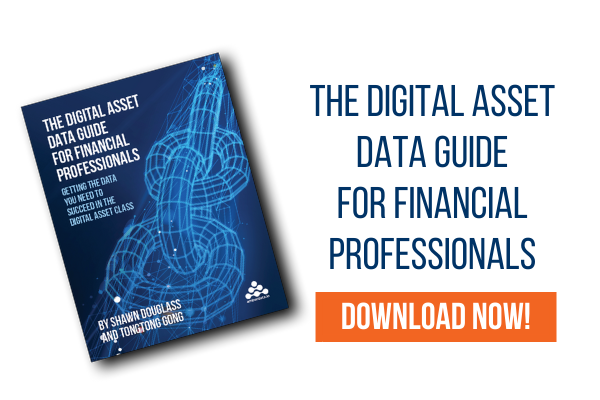Why is Blockchain Data So Hard to Collect and Work With?

In order to effectively answer questions related to research, trading, risk, custody, analytics, reporting, and compliance, financial institutions seeking to enter and succeed in the digital asset class need more than just market data. They also need comprehensive on-chain data collected directly from the blockchains they are interested in.
With the growth of DeFi, the need for blockchain data will only grow, but this data is very difficult to access and work with.
Let’s take a look at why.
1. Number of Data Sources
There are now many blockchains and a rapidly growing ecosystem of decentralized exchanges and DeFi dApps that power trading across thousands of cryptoassets. Trading occurs globally and runs 24/7, so data needs to be collected constantly from all of these disparate sources.
Each blockchain and exchange has a different API, and they change frequently, making it difficult to keep up. It’s also difficult to maintain one blockchain node, never mind 20 or more. You need significant operational expertise to maintain the nodes and keep them available. And to access and extract the data, you need protocol-specific subject matter expertise.
2. Lack of Standardization
Each blockchain is a unique protocol with its own specifications that requires deep subject matter expertise to set up nodes and collect all data necessary. There are no standards around what types of data should be included in a transaction, and how it is stored and accessed in blocks.
It's important to understand that transactions enabled by smart contracts and dApps can have many sub-transactions, often across blockchains, liquidity pools, and decentralized exchanges. And to understand these transactions there is ephemeral data that must be captured that is not written to a block. If ephemeral data is not collected in-flight from all sources involved, these transactions cannot be properly replayed and analyzed.
DeFi adds additional layers to the challenge as there are multiple protocols and methods for settling trades.
3. Complex Data Processing Needs
Once collected, raw blockchain data needs significant pre-processing to turn it into actionable information for decision-making.
Each blockchain stores data in its own way, so different approaches will be needed to create data sets that are indexed, and normalized to time series. Doing this work requires deep expertise gained from years of blockchain experience.
Once raw blockchain data has been processed, the resulting data sets need to be correlated with price and activity data collected from centralized exchanges to create a complete picture.
Like data collection, this processing will need to take place on a 24/7 basis with high reliability.
Making matters more complicated is the advent of Layer 2. The webs of blockchains and cross-chain assets it will create will significantly increase interoperability issues and operational challenges.
4. Talent is Expensive and Hard to Find
One common factor in all of the challenges of collecting and working with blockchain data is the need for deep subject matter expertise. Demand for talent with the blockchain data skills financial institutions will need to enter the asset class on their own significantly exceeds supply, meaning that hiring will be expensive and time-consuming, while attempting to grow talent in-house could increase go-to-market time by several years.
What’s the Solution?
Fortunately, institutions seeking to enter the digital asset class do not have to develop or hire the expertise to access and process blockchain data on their own. There is no need to spend millions of dollars on building out expensive and complicated data infrastructure while struggling to recruit the necessary talent to develop and maintain it.
Instead, institutions can partner with a digital asset data provider that already has the necessary institutional-grade infrastructure and talent. By working with a trusted partner, you can get the blockchain data needed in the formats and with the reliability received with traditional asset classes, enabling you to get digital asset financial products and services to market quickly without having to make a massive investment in data infrastructure and blockchain expertise.
Why Amberdata?
Institutions looking for a digital asset data provider should consider Amberdata. Our platform connects to all the blockchains and markets that matter today. We provide real-time and historical transparency into markets and price discovery across spot, derivative and decentralized exchanges, as well as on-chain data from the most active cryptocurrency networks and protocols.
With Amberdata, you get a single integration point for market and on-chain data. We’ve built our data sets with institutional use cases in mind, providing the easy-to-consume formats and reliability you receive with traditional asset classes.
We know you don’t want to be in the data Infrastructure business if you don’t have to be. You want to concentrate on your core business, which is providing financial products and services to your customers. What you really need are the fundamentals, market structural insights and signals to inform and catalyze your decisions on cryptos and other digital assets.
Request a demo to find out how the Amberdata platform solves digital asset data challenges and enables institutions to enter the digital asset space quickly, easily, and reliably.
Amberdata
Amberdata is the leading provider of global financial infrastructure for digital assets. Our institutional-grade solutions deliver data, analytics and comprehensive tools and insights that empower financial institutions to research, trade, and manage risk and compliance in digital assets. Amberdata serves as a...

